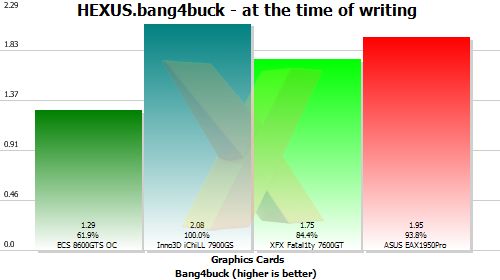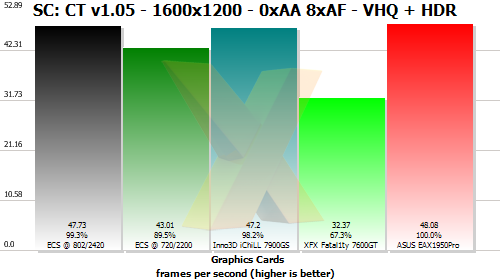HEXUS.bang4buck, overclocking and power draw
HEXUS.bang4buck
| Graphics cards | ECS N8600GTS 256MX+ | Inno3D iChill 7900GS Arctic Cooling Silencer 6 | XFX Fatal1ty 7600GT | ASUS EAX1950PRO |
|---|---|---|---|---|
| Actual aggregate marks at 1280x1024 4xAA 8xAF | 196.54 | 263.87 | 170.33 | 230.31 |
| Aggregate marks, normalised*, at 1280x1024 | 186.64 | 221.94 | 151.91 | 205.16 |
| Price | £145 | £106.81 | £86.67 | £105.27 |
| HEXUS.bang4buck score | 1.287 | 2.078 | 1.753 | 1.949 |
| Acceptable framerate (Av. 60FPS) at 1280x1024 4xAA 8xAF | No (SC) | Yes | No (SC, FC) | Yes |
* - The normalisation refers to taking playable framerate into account. Should a card benchmark at over 60FPS in any one game, the extra FPS counts as half. Similarly, should a card benchmark lower, say at 40FPS, we deduct half the difference from its average framerate and the desired 60FPS, giving it a bang4buck score of 30 marks. The minimum framerate, then, can be 20FPS, as that will score 0.
As an example, should a card score 120FPS we count it as 90FPS (120 - (120-60)/2) as only half the framerate above 60FPS is counted for the bang4buck. Similarly, should it score 30FPS we count it as only 15FPS (30 + (30-60)/2).
The reasoning behind such calculation lies with playable framerates. Should card A score 110FPS in a benchmark and card B 160, then card B would normally receive an extra 50 marks in our bang4buck assessment, even though both cards produce perfectly playable framerates and anything above 60FPS is a bonus and not a necessity for most. However, the bang4buck total would be identical if in another benchmark card A scored a smooth 70FPS and card B an unplayable 20FPS, as both aggregate to 180 marks, yet the games-playing experience would be vastly different. You would, on balance, say that card A was better because it ran smoothly in both games. In our revised aggregation, card A would receive 150 marks (85 + 65) and card B 100 (100 + 0).
In effect, we're including a desired average framerate, in this case 60, and penalising lower performance whilst giving higher-than 60FPS framerates half as much credit as the framerate up to 60FPS. If that doesn't make sense or you have issue with it, please hit the HEXUS community.

Now, the HEXUS.bang4buck graph simply divides the normalised marks by the current price, to give you an easy-to-understand metric that takes value into account.
What it doesn't do is convey any non-benchmark advantages such as DX10 compliance for better-looking visuals, hardware-accelerated video-decoding engine, or, for that matter, HDCP/dual-link connectivity. But one fact shines out like a beacon; the GeForce 8600 GTS is simply priced too high, and ECS cannot justifiably trash the price to, say, £100 without incurring NVIDIA's wrath.
Overclocking
We managed to raise the already-overclocked frequencies of 720/2200 to 802/2420. That's an 11 per cent/10 per cent increase, respectively, over shipping speeds. Here's how that was manifested in our SC:CT 16x12 HDR test.
Still not quite enough oomph to take top spot.
Temps and power
| Graphics cards | ECS N8600GTS 256MX+ | Inno3D iChill 7900GS Arctic Cooling Silencer 6 | XFX Fatal1ty 7600GT | ASUS EAX1950PRO |
|---|---|---|---|---|
| Ambient temps | 21.5°C | 19.5°C | 18.5°C | 19.5°C |
| Idle temps | 43°C | 42°C | 42°C | 39°C |
| Load temps | 66°C | 61°C | 56°C | 59°C |
| Ambient-Load difference (lower is better) | 44.5°C | 41.5°C | 37.5°C | 39.5°C |
| Peak power draw (system) | 130W | 134W | - | 141W |
The ECS N8600GTS-256MX+ doesn't run particularly warm and doesn't chew through too much power; the right attributes for a midrange card with a quiet-ish fan.









